Debian free linux based operating system under FreeBSD license
The Debian Project is a community of individuals who have made a common platform to create a free operating system under FreeBSD.
Advantages of using Debian OS:
1]Type: Free Open source operating system
2]Kernel: Comes with Linux kernel
3]License: Free BSD
4]Project Type: GNU
5]Packges supported: Over 590000
6]Package manager: Comes with basic APT
7]Hardware support: Almost all type of hardware is supported.
What is the Operating System:
The term operating system is a set of basic programs and utilities that make your computer execute tasks. At the core of an operating system, there is a module called a kernel. The kernel is the most core program on the computer that executes all the essential tasks or processing and helps you to start your installed programs.
Functions of Operating Systems:
1]Acts as an interface between user applications and the computer system.
2]Manages all memory-related activities.
3]Manages all Process-related activities.
4]Manages all storage-related activities.
5]Manages all peripherals-related activities.
6]Manages all User-related activities.
5]Manages all security-related activities.
A Debian OS installed systems currently use the Linux kernel or the FreeBSD kernel. Linux is a piece of software created by Linus Torvalds.now a days, Debian is accepted by thousands of programmers as well as community peoples worldwide. FreeBSD is a type of operating system which including a kernel and other software.
Debian is committed to free software that all the Linux users thought. It would be useful for all OS users. Debian works in the free software domain, so there are few cases where people need to put non-free software on their machines. There are several packages whose sole job is to install non-free software into a Debian system.
What hardware is supported?
Debian OS will be available to use on almost all personal computers, desktops, laptops, including most older models to the current new generation models. Each new version of Debian generally supports a large number of computer architectures like it is a 32-bit or 64-bit processor.
Debian supports all the well-known hardware. If you would like to be sure that all the devices connected to your machine are supported, you must then go through the Debian device driver check page.
Debian OS supported Hardware Architectures:
1]32-bit i386
2]64-bit amd64
3]64-bit arm
4]EABI arm
5]Hard float ABI arm
6]MIPS
7]Power processors
8]IBM Systems
In today's technology era, some companies make support difficult by not releasing specifications for their hardware and drivers pack. It means you might not be able to use their computing hardware with GNU/Linux or with Debian. Some of the companies will provide non-free or paid drivers. When you want to use, you should purchase the hardware from manufacturers that provide free drivers for their products.
Who uses Debian?
Since Debian does not require users to register for download and install, it is then installed and used by a wide range of organizations and users, large and small, as well as many thousands of individuals,
so it is quite popular than other versions of Linux.
Ways to Install Debian OS:
1]Download installation image.
2]Use the Debian Cloud image.
3]Create /Buy a set of Debian recorded CD/DVD
Debian Home Page:
https://www.debian.org/
How to download Debian OS:
https://www.debian.org/distrib/
Simple steps to install Debian 10 on your PC/Laptop:
Step 1: Download Debian 10 ISO file and create a bootable CD/DVD/USB.
Step 2: Boot System From CD/DVD/USB.
Step 3: Set Up Language, Location, and Keyboard preferences.
Step 4: Configure a Network to download updates.
Step 5: Set Up User name and Password.
Step 6: Create Disks Partition table For Debian 10.
Step 7: Finalize your Configuration.
Step 8: Start-Up Debian 10 installed system.





Comments
Post a Comment
Thanks for your valuable input